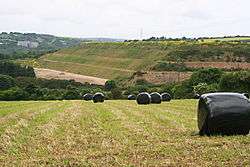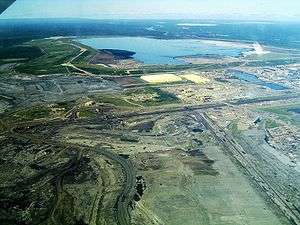Tailings dam
A tailings dam is typically an earth-fill embankment dam used to store byproducts of mining operations after separating the ore from the gangue. Conventional water retention dams can serve this purpose, but due to cost, a tailings dam is more viable. Tailings can be liquid, solid, or a slurry of fine particles. Solid tailings are often used as part of the structure itself.
Tailings dams rank among the largest engineered structures on earth. The Syncrude Mildred Lake Tailings Dyke in Alberta, Canada, is an embankment dam about 18 kilometres (11 mi) long and from 40 to 88 metres (131 to 289 ft) high. It is the largest dam structure on earth by volume, and as of 2001 it was believed to be the largest earth structure in the world by volume of fill.[1]
There are key differences between tailings dams and the more familiar hydro dams. Tailings dams are designed for permanent containment, meant to "remain there forever".[2] Copper, gold, uranium and other mining operations produce varied kinds of waste, much of it toxic, which pose varied challenges for long-term containment.[3]
An estimated 3,500 active tailings impoundments stand around the world, although there is no complete inventory, and the total number is disputed. As of 2000 these structures experience known "major" failures of about 2 to 5 annually, along with 35 "minor" failures.[4] Assuming the 3,500 figure is correct, this failure rate is "more than two orders of magnitude higher than the failure rate of conventional water retention dams".[5]
Structure
Unlike water retention dams, a tailings dam is raised in succession throughout the life of the particular mine. Typically, a base or starter dam is constructed, and as it fills with a mixture of tailings and water, it is raised. Material used to raise the dam can include the tailings (depending on their size) along with dirt.[6]

There are three raised tailings dam designs, the upstream, downstream and centerline, named according to the movement of the crest during raising. The specific design used is dependent upon topography, geology, climate, the type of tailings, and cost. An upstream tailings dam consists of trapezoidal embankments being constructed on top but toe to crest of another, moving the crest further upstream. This creates a relatively flat downstream side and a jagged upstream side which is supported by tailings slurry in the impoundment. The downstream design refers to the successive raising of the embankment that positions the fill and crest further downstream. A centerlined dam has sequential embankment dams constructed directly on top of another while fill is placed on the downstream side for support and slurry supports the upstream side.[7][8]
List of largest tailings dams
| Rank | Name[9] | Country | Year completed | Structure height [m] | Structure volume[10] [106 m3] | Reservoir volume [109 m3] | Installed capacity [MW] | Type |
|---|---|---|---|---|---|---|---|---|
| 1 | Syncrude Tailings Dam Mildred MLSB[11] | | 1995 | 88 | 540[12]/720 | 0.35 | NA | TE |
| 2 | Syncrude Tailings Dam Mildred SWSS[13] | | 2010 | 40-50 | 119[12] | 0.25[12] | NA | TE |
| 3 | ASARCO Mission Mine Tailings Dam | | 1973 | 30[14] | 40.1 | 0 [15] | NA | ER |
Type: TE - Earth; ER - Rock-fill; PG - Concrete gravity; CFRD - Concrete face rock fill
Concerns
The standard of public reporting on tailings dam incidents is poor. A large number remain completely unreported, or lack basic facts when reported. There is no comprehensive database for historic failures.[5]
Failure rate
The lack of any comprehensive tailings dam database has prevented meaningful analysis, either gross comparisons (such as county to country comparisons, or tailings dam failures versus hydro dam failure rates) or technical failure analysis to help prevent future incidents. The records are very incomplete on crucial data elements: design height of dam, design foot print, construction type (upstream, downstream, center line), age, design life, construction status, ownership status, capacity, release volume, runout, etc.
An interdisciplinary research report from 2015 recompiled the official global record on tailings dam failures and major incidents and offered a framework for examining the severity and consequence of major incidents. That report shows a correlation between failure rates and the pace of copper ore production, and also establishes a relationship between the pursuit of lower grades of ore, which produces larger volumes of waste, and increasingly severe incidents.[16][17]
Environmental damage
The mining and processing byproducts collected in tailings dams are not part of the aerobic ecological systems, and are unstable. They may damage the environment by releasing toxic metals (arsenic and mercury among others), by acid drainage (usually by microbial action on sulfide ores), or by damaging aquatic wildlife that rely on clear water.[18]
Tailings dam failures involving significant ecological damage include:
- the Bento Rodrigues dam disaster, Brazil, November 5, 2015, considered the worst environmental disaster in Brazil's history,[19][20] killed at least 17 when an iron ore containment dam failed and released 60 million cubic meters of iron waste
- the Mount Polley mine disaster, British Columbia, August 4, 2014
- the Ok Tedi environmental disaster on New Guinea, which destroyed the fishery of the Ok Tedi River, continuously from 1984 through 2013
- the Ajka alumina plant accident, Hungary, October 4, 2010
- the Baia Mare cyanide spill, Romania, January 30, 2000, called the worst environmental disaster in Europe since the Chernobyl disaster[21]
- the Church Rock uranium mill spill in New Mexico, July 16, 1979, the largest release of radioactive waste in U.S. history [22]
Tailings ponds can also be a source of acid drainage, leading to the need for permanent monitoring and treatment of water passing through the tailings dam. For instance in 1994 the operators of the Olympic Dam mine, Western Mining Corporation, admitted that their uranium tailings containment had released of up to 5 million m3 of contaminated water into the subsoil.[23] The cost of mine cleanup has typically been 10 times that of mining industry estimates when acid drainage was involved.[24]
Casualties
The following table of the deadliest known tailings dam failures is not comprehensive, and the casualty figures are estimates.
| Dam/incident | Year | Location | Fatalities | Details |
|---|---|---|---|---|
| 1962 Huogudu, China tailing pond failure | September 1962 | Huogushan (?) or Huogudu, China | 171 | Few details available. A tailings pond at a tin mine operated by Yunnan Tin Group collapsed. One source reports 171 killed and another 92 injured; another has the date as September 26.[25][26] |
| Mina Plakalnitsa | 1966-05-01 | Vratsa, Bulgaria | 480+ | A tailings dam at Plakalnitsa copper mine near the city of Vratsa failed. A total 450,000 cu m of mud and water inundated Vratsa and the nearby village of Zgorigrad, which suffered widespread damage. The official death toll is 107, but the unofficial estimate was more than 480.[27] |
| Certej dam failure | 1971-10-30 | Certej Mine, Romania | 89 | A tailings dam built too tall collapsed, flooding Certeju de Sus with toxic tailings.[28] |
| Buffalo Creek Flood | 1972-02-26 | West Virginia, United States | 125 | Unstable loose constructed dam created by local coal mining company, collapsed in heavy rain. 1,121 injured, 507 houses destroyed, over 4,000 left homeless. |
| Val di Stava dam | 1985-07-18 | Tesero, Italy | 268 | Poor maintenance and low margin for error in design; outlet pipes failed, leading to pressure on dam and sudden collapse. Ten people were ultimately convicted of manslaughter and other charges. |
| Mufulira | 1970 | Zambia | 89 | A tailings reservoir breached and collapsed into the copper mine below it, killing 89 night-shift workers.[29] |
| Aberfan disaster | 1966-10-21 | Wales | 144 | The collapse and landslide of a spoil tip accumulated above the mining town on geologically unstable ground killed 28 adults and 116 children (not an engineered structure) |
| Hpakant jade mine disaster | 2015-10-25 | Myanmar | 113 | A slag heap reportedly used by multiple operators in this jade-mining region became unstable and flooded into nearby residences (not an engineered structure) [30] |
| El Cobre landslide | 1965-03-28 | Chile | 300 | Shaking from a magnitude 7.1 earthquake caused failure of two tailings dams at the El Soldado copper mine. The resulting flow destroyed the town of El Cobre. |
| Taoshi landslide | 2008-09-08 | Linfen, Shanxi Province, China | 254+ | Iron mine tailings, formerly administered by the state and then put into private hands, collapsed into a village at 8 a.m.[31] |
See also
References
- ↑ Morgenstern, Norbert R. (19–20 September 2001), Geotechnics and Mine Waste Management – Update (PDF), Swedish Mining Association, Natur Vards Verket, European Commission, retrieved 2014-04-27
- ↑ http://www.pbs.org/wgbh/frontline/article/tailings-dams-where-mining-waste-is-stored-forever/
- ↑ http://www.vancouversun.com/technology/tailings+dams+work/10102756/story.html?__lsa=60ea-4ffb
- ↑ http://www.infomine.com/publications/docs/Martin2000.pdf
- 1 2 http://www.infomine.com/library/publications/docs/Azam2010.pdf
- ↑ Blight, Geoffrey E. (1998). "Construction of Tailings Dams". Case studies on tailings management. Paris, France: International Council on Metals and the Environment. pp. 9–10. ISBN 1-895720-29-X. Retrieved 10 August 2011.
- ↑ "Properties of Tailings Dams" (PDF). NBK Institute of Mining Engineering. Retrieved 10 August 2011.http://mining.ubc.ca/files/2013/03/Dirk-van-Zyl.pdf
- ↑ Environmental issues and management of waste in energy and mineral production: Proceedings of the Sixth International Conference on Environmental Issues and Management of Waste in Energy and Mineral Production: SWEMP 2000; Calgary, Alberta, Canada, May 30 – June 2, 2000. Rotterdam [u.a.]: Balkema. 2000. pp. 257–260. ISBN 90-5809-085-X. Retrieved 2015-11-09.
|first1=missing|last1=in Authors list (help) - ↑ Talk:List of largest dams in the world#Phantom Dams
- ↑ Talk:List of largest dams in the world#Structure Volume
- ↑ D. Nicol (1994) "The Syncrude Mildred Lake Tailings Dyke Redesign", 18th Int. Congr. Large Dams.
- 1 2 3 Estimate based on height, dimensions from Google Earth and, where available, cross section. Accuracy ±15%
- ↑ "Microsoft Word - Baseline Report on Fluid Deposits revE" (PDF). Retrieved 2011-02-16.
- ↑ Estimate based on structure volume and dimensions from Google Earth
- ↑ Zero reservoir size because full of tailings
- ↑ http://csp2.org/files/reports/Bowker%20%26%20Chambers%20-%20Risk-Public%20Liability-Economics%20of%20Tailings%20Storage%20Facility%20Failures%20%E2%80%93%2023Jul15.pdf
- ↑ http://www.csp2.org/tailings-dam-failures-1915-2014
- ↑ Franks, DM, Boger, DV, Côte, CM, Mulligan, DR. 2011. Sustainable Development Principles for the Disposal of Mining and Mineral Processing Wastes. Resources Policy. Vol. 36. No. 2. pp 114-122
- ↑ http://tvuol.uol.com.br/video/boechat-mariana-e-a-maior-tragedia-ambiental-do-brasil-04024C9B3162DCB15326
- ↑ http://www.ihu.unisinos.br/noticias/549187-e-a-maior-tragedia-ambiental-do-brasil-mas-tem-solucao
- ↑ "Death of a river", BBC, February 15, 2000
- ↑ http://www.eenews.net/stories/1059957572
- ↑ http://www.world-nuclear.org/info/nuclear-fuel-cycle/mining-of-uranium/environmental-aspects-of-uranium-mining/
- ↑ Jared Diamond (2005). Collapse. Penguin., page 452-458
- ↑ The present situation and prospects for safety online-monitoring system of tailings pond (sic), by ZHOU Hanmin, YUAN Ziqing, SU Jun, YANG Xiaocong and ZHANG Da1, paper presented for the 3rd International Conference on Mechatronics, Robotics and Automation (ICMRA 2015)
- ↑ http://resources.alibaba.com/topic/800030605/Introduction_tailings_dam.htm
- ↑ http://zgorigrad.com/tragediata
- ↑ "Certej 1971, tragedia uitată a 89 de vieţi îngropate sub 300 de mii de metri cubi de nămol". Adevărul. 31 August 2013. Retrieved 30 March 2013.
- ↑ http://www.tailings.info/casestudies/mufulira.htm
- ↑ http://www.aljazeera.com/news/2015/11/deaths-reported-myanmar-jade-collapse-151122032719542.html
- ↑ http://www.asianews.it/news-en/Taoshi-landslide:-hundreds-dead,-mine-owner-and-government-accused-13188.html
Further reading
| Wikimedia Commons has media related to Tailings dams. |

.jpg)